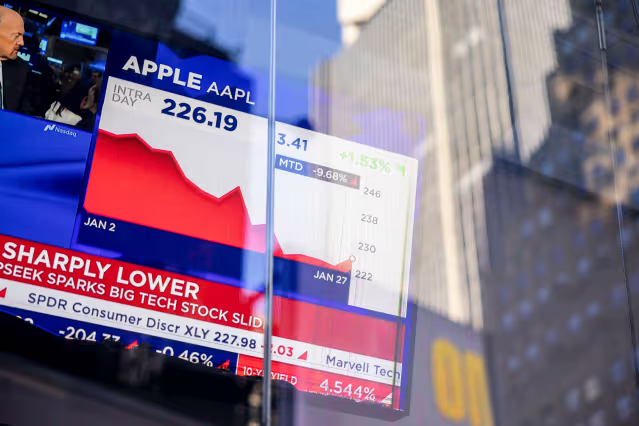In the fast-paced world of the stock market, especially when it comes to tech stocks, price movements can be unpredictable. For companies like Nvidia and Salesforce—giants in the tech sector—after-hours trading often becomes a crucial period that significantly affects their stock prices. But what exactly happens after the closing bell, and why do prices move so dramatically?
This article explores the mechanics of after-hours trading, its impact on popular tech stocks, and what investors need to understand when tracking price swings after the market officially closes. Whether you’re a new investor or a seasoned trader, decoding this hidden layer of the market can help you make more informed decisions.
What is After-Hours Trading?
After-hours trading refers to the buying and selling of securities outside of regular trading hours, which for U.S. markets are from 9:30 a.m. to 4:00 p.m. Eastern Time. Trading that occurs from 4:00 p.m. to 8:00 p.m. ET is considered after-hours. There is also pre-market trading that happens before the market opens, generally from 4:00 a.m. to 9:30 a.m.
Unlike regular trading sessions, after-hours trading is limited to electronic communication networks (ECNs) where buyers and sellers are matched without the involvement of traditional market makers.
Why Do Investors Trade After Hours?
There are several reasons investors might want to trade after the closing bell:
- Reacting to Earnings Reports: Many tech companies like Nvidia and Salesforce release quarterly earnings after the market closes. Traders often jump in quickly to buy or sell based on the numbers.
- Global News Events: Tech stocks are especially sensitive to international developments—new regulations in China, semiconductor shortages, or cybersecurity incidents can all prompt immediate reactions.
- Institutional Activity: Hedge funds and institutional investors may initiate trades after hours to manage positions discreetly or respond to macroeconomic indicators.
- Volatility Opportunities: Some traders specialize in profiting from the larger-than-usual price swings that often happen after hours.
How After-Hours Trading Works
In regular market hours, trades are executed through centralized exchanges like the NYSE or NASDAQ. But in after-hours trading, transactions happen on ECNs, which have lower liquidity and a narrower pool of participants.
Because of this, price spreads—the difference between the bid (buy) and ask (sell) prices—tend to be wider. That means it’s easier for prices to swing sharply in either direction based on limited volume.
Let’s say Nvidia releases better-than-expected earnings at 4:05 p.m. A limited number of buyers and sellers react immediately, pushing the stock up 5% within minutes. However, with fewer trades taking place, this price swing may not represent the broader market sentiment.
Case Study: Nvidia’s Earnings Surprises and After-Hours Surges

Nvidia has become a poster child for after-hours volatility. As a leading producer of GPUs and a key player in artificial intelligence (AI), its quarterly earnings are watched closely by both retail and institutional investors.
In several instances over the last few years, Nvidia’s shares have surged 8–10% in after-hours trading based on strong sales and positive forward guidance. In August 2023, for example, the company posted record revenues thanks to booming demand in AI chips. By 4:15 p.m., the stock had already gained 7% after the bell.
But these after-hours jumps don’t always hold. When regular trading resumes the next day, the broader market may respond differently. Sometimes, profit-taking or analyst downgrades in the morning can erase those gains.
Case Study: Salesforce and Cloud Sentiment Shifts
Salesforce, the cloud-based CRM giant, also frequently experiences sharp after-hours movements. As a leader in SaaS (Software as a Service), its results often serve as a barometer for the entire cloud computing sector.
In one notable quarter, Salesforce exceeded earnings estimates but issued cautious forward guidance. After-hours trading initially pushed the stock up 4% on the earnings beat, but within an hour, the stock reversed course and fell nearly 3% as investors digested the weaker forecast.
This kind of volatility illustrates the importance of not reacting impulsively to after-hours price movements without understanding the full context.
Risks and Challenges in After-Hours Trading
1. Low Liquidity
There are simply fewer people trading during these hours, which means it’s harder to execute large trades without affecting the price.
2. Wider Spreads
Bid-ask spreads can be significantly wider in after-hours trading, leading to less favorable pricing for retail investors.
3. Increased Volatility
Smaller trades can cause larger price movements, making it difficult to gauge a stock’s real value.
4. Lack of Transparency
News may not be fully disseminated, and many investors may not yet have reacted to a company’s announcements.
5. No Circuit Breakers
During regular trading hours, markets have volatility halts (circuit breakers) to prevent flash crashes. These don’t exist after hours, increasing the risk of exaggerated price swings.
How to Monitor Tech Stocks in After-Hours Trading
If you want to keep tabs on what’s happening with tech stocks like Nvidia or Salesforce outside of regular hours, here are a few tools and tips:
- Use Real-Time ECN Quotes: Platforms like Nasdaq TotalView or TD Ameritrade offer extended-hours quotes.
- Follow Earnings Calendars: Know when companies are scheduled to report.
- Watch Futures Markets: Index futures (like S&P 500 E-mini) give clues about the broader market sentiment.
- Set Limit Orders: Market orders can be risky after hours. Use limit orders to control execution price.
- Read the Full Earnings Report: Don’t react based on headlines. Dive into revenue, margins, and guidance.
What Drives Tech Stock Prices After Hours?
Several factors can affect how tech stocks perform in after-hours trading:
- Earnings Reports
- Product Launches or Delays
- Executive Changes
- Regulatory News
- M&A Activity (Mergers and Acquisitions)
- Macroeconomic Data (e.g., interest rate decisions)
For example, when Nvidia announced a major partnership with a cloud provider, its stock surged after hours. But when Salesforce’s CEO unexpectedly stepped down, the market reacted negatively despite solid earnings.
Strategies for Trading Tech Stocks After Hours
Trading after hours isn’t for everyone, but if you choose to participate, consider the following strategies:
1. News-Based Trading
Quickly digest and act on breaking news or earnings reports. This is a high-risk, high-reward strategy.
2. Gap Trading
Trade based on the price “gap” between the after-hours price and the previous close. Some traders aim to profit from this gap narrowing or widening the next morning.
3. Volatility Plays
Expect large movements in response to key catalysts. Options traders might use straddles or strangles before earnings.
4. Fade the Move
Some traders bet that extreme after-hours moves will fade once the market opens and more participants weigh in.
Should Retail Investors Participate?
Retail investors should proceed with caution. While tech stocks like Nvidia and Salesforce can offer tempting opportunities, the risks of after-hours trading are real.
If you’re new to investing:
- Avoid trading based solely on emotion
- Don’t chase price swings blindly
- Start small if you’re testing the waters
- Use a brokerage that supports extended-hours trading
- Always do your homework before making a move
Long-Term Investing vs. After-Hours Speculation
It’s important to distinguish between long-term investing and short-term after-hours speculation.
- Long-Term Investors: Focus on fundamentals, growth prospects, competitive edge, and valuation. After-hours price changes are usually noise.
- Short-Term Traders: May benefit from volatility but require strict discipline, risk management, and a clear exit strategy.
Understanding this difference can help you avoid making hasty decisions based on temporary price movements.
How Media Coverage Influences Tech Stock Volatility
Financial media plays a huge role in amplifying after-hours price swings, especially for tech companies with strong retail interest.
A single CNBC headline or a viral tweet from a financial influencer can ignite buying or selling frenzies. This effect is magnified during the quiet after-hours sessions.
Being aware of media hype versus actual financial performance is critical when evaluating tech stock movements.
The Role of Institutional Investors
Large institutions often drive after-hours activity due to their access to faster, more powerful trading tools and analysis. When they adjust portfolios based on earnings or sector rotation, it can create outsized moves in stocks like Nvidia or Salesforce.
These trades are often invisible to retail investors until the next day when market volume increases and the price settles.
Tools and Platforms That Support After-Hours Trading
Not all brokerages allow after-hours trading. Some of the platforms that do include:
- TD Ameritrade
- Fidelity
- Charles Schwab
- Interactive Brokers
- E*TRADE
- Robinhood (limited hours)
Each platform has its own rules and hours of operation. Be sure to understand them before placing trades.
Psychological Traps to Avoid
After-hours trading comes with emotional pitfalls:
- FOMO (Fear of Missing Out): Jumping into a move too quickly.
- Overconfidence: Thinking you know more than the market.
- Revenge Trading: Trying to make up for losses by trading impulsively.
- Confirmation Bias: Ignoring contrary signals because you want to believe your trade is right.
Staying objective and detached is critical in this environment.
Final Thoughts: The Bigger Picture of Tech Stock Investing
After-hours trading provides a fascinating glimpse into investor psychology, institutional moves, and market sentiment. While Nvidia and Salesforce may see wild swings after the bell, these moments often represent short-term noise rather than long-term direction.
If you’re a trader, these opportunities can be lucrative—if managed correctly. For investors focused on building wealth, after-hours moves should be studied but not obsessed over.
Understanding the mechanics of extended trading hours adds another layer to your investment strategy, especially in the dynamic world of tech stocks.
Summary: Key Takeaways
- After-hours trading occurs from 4:00 p.m. to 8:00 p.m. ET and is driven by ECNs.
- Price swings are common in tech stocks like Nvidia and Salesforce due to earnings and breaking news.
- Low liquidity and wider spreads increase the risks and volatility.
- Retail investors should proceed cautiously and use limit orders.
- Long-term strategies shouldn’t be dictated by short-term after-hours fluctuations.

